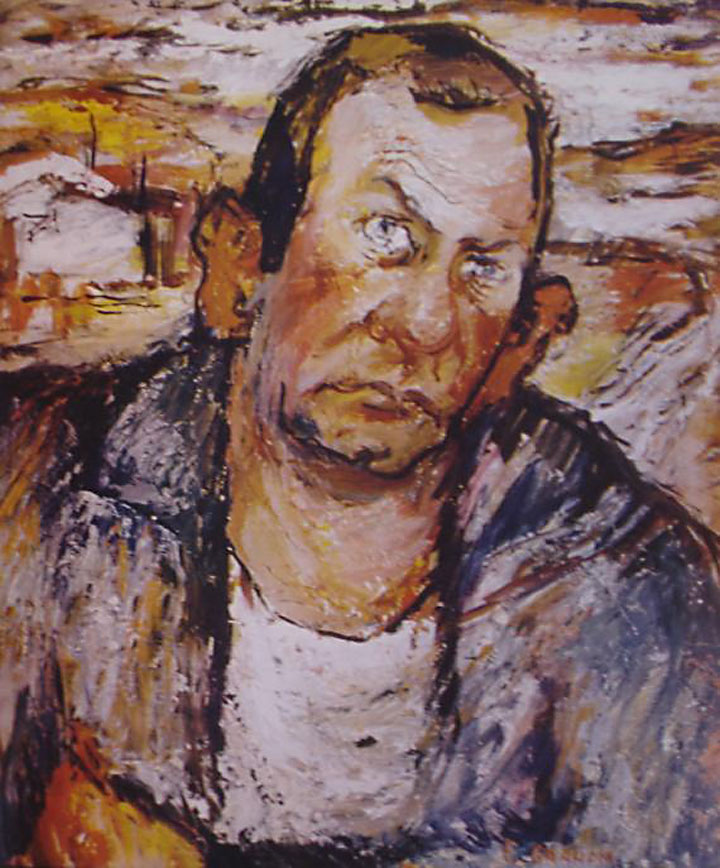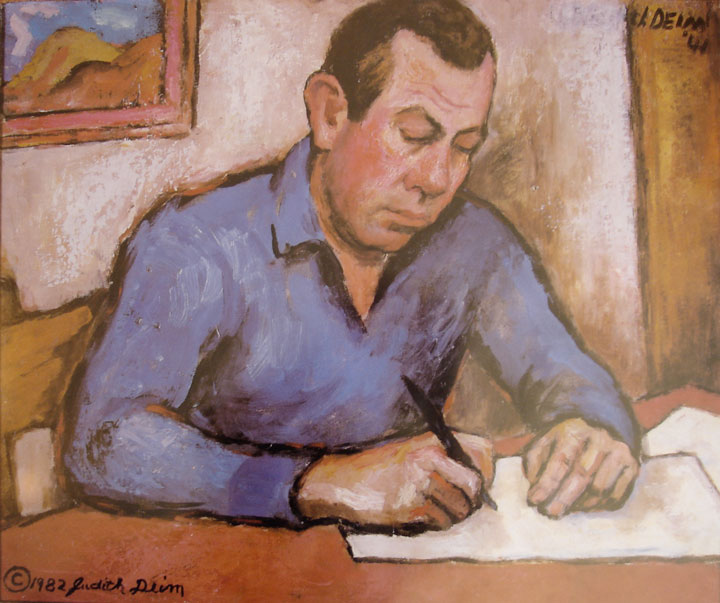In the late 1950s I rented a house owned by Barbara Stevenson and Ellwood Graham, artists who knew John Steinbeck when he was writing his 1935 hit Tortilla Flat, at the end of Lobos Street on Huckleberry Hill in Monterey, California. By then Graham and Stevenson—who later adopted the name Judith Deim—had decided to go their separate ways, Ellwood to San Francisco and Seattle, Barbara to live with her four young children in a cave in Spain.
What worldly goods the couple possessed, including a number of Barbara’s paintings that I found leaning against the walls of the three rooms in their small studio-home, were being left behind for the time being. As I unpacked and stored my clothing in the bedroom, I made a surprising discovery behind a pair of sliding closet doors: the now-missing and much-speculated-about portrait of John Steinbeck painted by Ellwood Graham some years earlier.
Barbara was still in the process of vacating the house when I began my move, and I mentioned that I didn’t particularly like Ellwood’s painting (shown above) because I thought Ellwood had made John look like a punch-drunk boxer. Neither agreeing nor disagreeing with my reaction to the work, Barbara told me how it came to be painted.
Barbara recalled that John did much of his early writing in the garage of the Steinbeck family cottage, located down the Hill on 11th Street in Pacific Grove. Like everyone living on the Hill, Barbara and Ellwood were aware that John and his wife Carol had made an unusual arrangement: each morning Carol locked John in the back-garden garage until late afternoon. The garage had a window or two, so there was a way out in case of emergency, but as Barbara explained, John was easily distracted and felt he needed the kind of discipline forced on him by daily isolation when he wrote.
As Ellwood and Barbara sat with John in their kitchen one evening, enjoying a jug of red wine at a massive hand-hewn redwood table with matching picnic table benches, John complained that he was struggling with a story he was trying to write about some of the lively characters who inhabited nearby Cannery Row. Refilling their glasses, Ellwood stated that he thought the material seemed limitless and suggested that John ought to be writing a novel, not a short story. John replied that he couldn’t imagine looking down at a blank page in another new ledger book knowing “I’d still be working on the same damn thing two years from now.”
Ellwood made a proposal: rather than sitting alone in his garage each day, John should move his writing ledgers and his sharpened pencils into their kitchen, where he could write and Ellwood and Barbara could each paint his portrait. Without hesitation, John agreed. Perhaps with the help of their good friend Bruce Ariss, the artist-author who lived next door, Ellwood hurriedly built a portable box-like platform approximately 14 inches high, large enough to accommodate John’s table and chair. It was there that John Steinbeck wrote portions of Tortilla Flat, his first commercially successful book, while Barbara and Ellwood painted their soon-to-be-famous friend from remarkably different points of view.
Today Barbara’s well-known painting, showing Steinbeck seated at his desk writing (above), can be viewed at the Martha Heasley Cox Center for Steinbeck Studies at San Jose State University. What happened to Ellwood’s portrait of the writer remains a mystery.
(By the way, the similar sound of our names meant that John Steinbeck and I were frequently confused for one another in the minds of some people in Monterey, California. There were occasions when I’d receive checks made out to “John Steinbeck.” I always endorsed them, and I never had trouble cashing one. I mentioned this to John when I saw him in Pacific Grove while he was visiting his sister at some point in the 1960s—the Vietnam War was on, but I don’t remember the exact year—and he said he’d do the same if he ever got a check made out to “John Smithback.” Even-Steven.)




I read John Smithback’s story about Elwood Graham and Barbara Stevenson/Judith Deim’s account of when they painted Johns portrait with great interest. I had never heard of this version. I did some research and Barbara’s account is much different from the one Benson had in his biography, Also different from Elwood Graham version he told in his interview with George Robinson. It is different from the one Steve Hauk wrote about in his Red Room article. Hauk also speculates about where the missing Graham portrait was and is.
http://redroom.com/member/steve-hauk/blog/the-missing-steinbeck-portrait
http://judithdeim.blogspot.com has a different version.
On pages 475/6 of the paperback edition of Jackson Benson’s biography of john Steinbeck there is the account that I believe is the correct one. In the spring of 1941, while Carol was in Hawaii and his girlfriend, Gwyn Conger was visiting him in Pacific Grove; John hired Elwood Graham to paint his portrait. He walked to Graham’s studio, where he spread out his material while writing Sea of Cortez. “Graham sketched him in various attitudes, trying to get the sense of the man and his emotions”. These sketches are at the Center for Steinbeck Studies, San Jose State University, and San Jose, CA. The expression that Graham painted “seems to be that of resigned anguish”.
It is interesting that Benson does not mention Judith Deim’s presence.
The National Steinbeck Center, Salinas, CA has some letters between John Smithback and John Steinbeck. Interesting reading.
Herb Behrens
What did you do with Ellwood’s painting?
When I moved into the house, Barbara was in the process of packing for Spain with her young children. As described, I saw the Elwood painting in a bedroom closet. I pulled it out to have a look, and I’ve written what Barbara had to say about it. The painting, along with some personal goods belonging to Barbara — some clothing and personal items, including a typed manuscript (perhaps a novel?) bound in soft leather — stayed in the closet.
At that time, her painting of John was also in the closet. It was signed “Stevenson”, by the way.
I remained in the house for more than four years, dutifully depositing the rent each month at a downtown Monterey savings and loan. I’d occasionally get a letter from Barbara enquiring about things for, with my brothers Bruce and Jim who were attending Monterey Peninsula College, we were minding her Cannery Row Art Gallery. Bruce and Jim lived at the gallery, showing Barbara’s paintings to visitors.
At one point Barbara wrote that she was willing to part with the house and asked if I was interested in buying it. I had the house appraised and was in the process of negotiating a loan when, out of the blue, a woman knocked on the door one evening and introduced herself as the new owner. She showed me the title and said I had thirty days to vacate her house. I might have fought that decree, but didn’t. I packed my things and left the house and all that was in it, including a broken piano, perhaps six or eight of Barbara’s paintings, and the two portraits of John Steinbeck done by Elwood Graham and Barbara Stevenson.
Elwood, by the way, had been away from Monterey for some time but returned to his studio about seven months before I moved away. His more-modern studio was further up the property close to the Presidio fence, and as the entire plat — the main house, Barbara’s studio just next to the main house, and Elwood’s studio up the hill — had been divided during the time of their divorce, Elwood lived there sans water, sans electricity for a time before selling his studio. At the time I was discussing terms with Barbara, she was asking $14,500 for the house, which included her adjoining one-bedroom studio. A check over at Zillow today says the house (without the studio) is valued at approximately $559,796.
I paid Barbara $65 a month to rent the house. Zillow says today’s rent should be in the neighborhood of $2,500. I’m left to wonder: Is that price with or without Elwood’s painting of John Steinbeck?